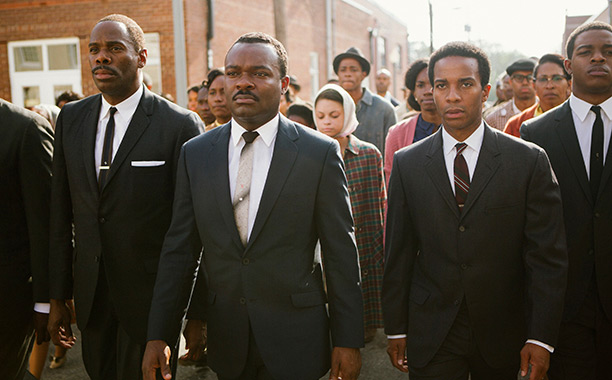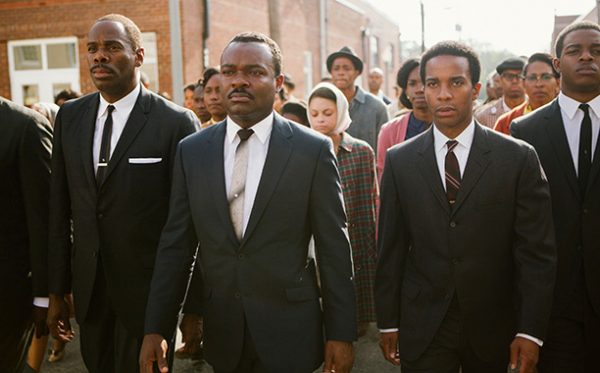
Verdict: Inspiring and uplifting, Selma avoids the mistakes of other biopics and is the movie to watch during this week of celebration for the life of Dr. Martin Luther King Jr.
It is not uncommon to see the history of important personalities on the silver screen. These movies are generally long and unfocused, as it is difficult to fit an entire life within two hours.
Luckily, Selma does not suffer from this issue. The movie shines in several aspects, including the screenplay, well focused on one moment of Dr. Martin Luther King Jr.’s life and directing, featuring powerful shots that often speak to the audience without the need of dialogue or music. Director Ava DuVernay never over dramatizes her shots. With beautiful cinematography and a cast delivering unforgettable performances, DuVernay does what best director of a narrative feature can do: let the story come across the screen with simple and straightforward editing.
The movie tells the story of the march Dr. King led from Selma, Alabama to Montgomery. The march took place in 1965 and was met with violence by state troopers on Edmund Pettus Bridge in Selma. This violence led to President Lyndon Johnson passing the crucial Voting Rights Act of that year.
The movie shows Dr. King’s fight to get the march underway and to convince President Johnson to pass the act allowing all people to vote without barriers such as the poll tax.
The short time span the movie covers allows the DuVernay to portray Dr. King in his intimacy and not just as the American hero he became. These personal scenes add depth to his character. Instead of portraying him just as an idol, DuVernay makes him a real man who struggles with the relationship with his wife and his own goals and dreams.
The movie begins as Dr. King chooses a tie for the reception of his Nobel prize. Unsure about his choice, he asks his wife, Coretta, for help. As the two talk, the conversation evolves into their own dreams about the future: a quiet life in a small Southern town, with King as a church pastor and college professor, giving a few speeches here and there. The common, daily decision of what tie to wear, and these simple dreams, similar to the dreams of millions of others, humanize the movie. Dr. King is, first of all, a man, just like all others. This portrait is one of the features that sets Selma apart from other biopics where the human side of these persons is overlooked, making these films into historical essays.
The cast in Selma only elevates this powerful story. David Oyelowo’s performance as Dr. King is inspiring and never overdone. Leading the march to Montgomery, Oyelowo plays Dr. King, the hero as the world saw him. In a powerful moment, he kneels down at Edmund Pettus Bridge, and spends seconds in silent prayer before leading the marchers back to Selma, away from danger. Heroes also need their own reflection and quiet time. The scene is silent as words are not needed.
The rest of the cast also never fails to deliver. Carmen Ejogo does great work in her role as Coretta Scott King, Dr. King’s wife. Her powerful expressions often say more than her words. When reading a letter from Dr. King at the moment they become temporarily separated, Ejogo’s face reveals love, sadness and understanding at the same time. It is not easy to love a national leader and to keep a marriage together while King is often not present at home and risking his life. All these elements are present in Ejogo’s performance and these opposing forces shape her fascinating character. More screen time on her character could have improved an already good film.
DuVernay shows her style in directing in scenes such as when the march begins. The beautiful shots of the united marchers are accompanied by soft music. DuVernay never lets this music dictate the scene for the images hold power on their own. It is great to witness this type of directorial control, where the cinematography, not the musical score, tells the story.
She accomplishes a similar effect early on in the film when portraying the bombing in a church in Birmingham that killed four African American girls. Although here the slow motion effect seems clichéd – a Hollywood convention – the next shot captures the four bodies amidst the destruction in a powerful image. In this shot, without the slow motion, DuVernay’s shows the beauty of her directing and her potential for a bright future behind the camera.
It is difficult to give any recent film an A+. While Selma can certainly be capable of that grade, only time can tell whether it will be remembered for years to come. Selma certainly is, however, an achievement. Figures like Dr. King are already immortal. It is only right and appropriate that their stories are told through a medium that preserves forever stars that should never stop shining.


